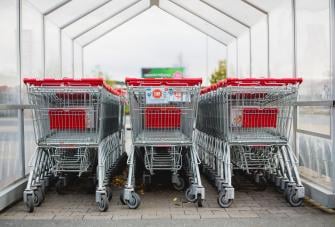Retail Strategies to Help You Manage Your Business
As a retailer, you're responsible for your employee well-being and productivity, your brand and retail marketing strategy, and merchandise, all while keeping your eyes out for increased competition. It can all be overwhelming.
Breaking your retail strategy down into its components can be useful and makes running your retail business much easier. So what do you need to focus on to get your store trading the way you want? What tools do you need? And what factors affect success? We provide some ideas, along with further links to further reading and advice to help you take care of your business.
Knowledge guides change
Whether you run a physical store, an e-commerce venture, or sell across multiple channels knowing more about consumer behavior, your employees, your target market, and the perceived value of your products can help you make better decisions. POS reporting helps retail stores gather this information by reading and documenting transaction data.
These reports can help guide strategy in every area to drive sales, reach new customers, and improve services. For example, when attracting customers, changing prices and comparing new sales data might indicate whether a product might be perceived as having poor value.
Similarly, adding more staff to the rota and comparing total sales over time could sugge st that employees providing more personal, attentive service might improve customer experience and help increase sales. These examples can only be quantified using POS reports that provide details on purchases over time.
A holistic marketing plan
The advantage of reporting data is that it helps businesses to assess both in-store and online performance and spot areas for improvement. Retailers buy product lines that create opportunities to target customers (existing customers or to attract customers in new areas). But it's retail marketing efforts that really help drive the company to success by shouting about these products and reaching more customers.
A strong retail marketing strategy includes targeting different kinds of customers in different ways. Customers that already know who you are and have visited and purchased before need customer relations management (often shortened to CRM). You can do this by communicating via social media, email marketing (including a company newsletter), and SMS.
Aim when you advertise
Directing your marketing efforts in different ways can lead to fruitful results. A traditional marketing mix will involve informing customers about new deals, new products, bestsellers, and details like opening times.
But informative marketing will also provide color about other developments in the business. This could mean writing about staff changes, personality pieces on the team, events taking place at the business that customers can get involved in or might like to hear about, expansion plans, or even more journalistic pieces about what's been going on.
It's crucial to obtain consent before marketing to your customer base. Email receipts provide an opportune means of taking an email from a customer. Quickly asking whether or not the customer would like to receive marketing communications will help you build a base you can contact, keeping them updated on your business and reminding them you're there.
What about marketing to other shoppers?
There are plenty of ways to help make your retail outlets more attractive to consumers. Leafleting and other forms of physical advertising still help stores sell to the local community but cannot provide much of a boost for online sellers.
However, local inventory advertising combines the online and physical realms by advertising online to consumers who search for your products while close to your shop. This method allows retailers to only pay for an advert when a web user expresses interest in something they offer and are close enough to buy it from your store. This makes it a very efficient method of advertising to new, local, and likely customers.
A physical presence for an online business
Despite the cost-effective, far-reaching nature of online marketing, having a physical presence and an in-person encounter with customers can lead to a stronger relationship with those fuelling your business.
The complementary nature of online and physical trading can lead even online businesses to operate and market on multiple channels. For this reason, many online retail store enterprises choose to visit towns and cities with pop-up shops that provide them with a secondary revenue stream while creating links to communities, providing a more complete shopping experience, and the opportunity to promote the online business in a new way.
Nothing revitalizes your business like an Epos Now system. With user-friendly, simple business solutions, you can integrate all parts of your operation into one time-saving system. Epos Now customers benefit from:
- In-house and third-party software for the very best choices for accounting, marketing, loyalty programs and much more
- Streamlined transaction programs that save staff and customers time, with the flexibility to create the system that suits your needs
- Cloud-based technology that gives management full control and access no matter where you are, with programmable access for different parts of the organization for added security

Branding that builds your base
No matter how you choose to market or the tone in which you communicate, every time you engage with a customer you create your retail brand. Branding involves expressing your company values, giving customers a sense of whether you're friendly, formal, cool, or creative.
Customers get a sense of the retail experience you'll provide even before they step through the door based on the first impression of your brand. This could be your store decoration or window display, or it could be from word-of-mouth. Nevertheless, the decision to purchase or even enter gets made based on brand.
Your retail marketing efforts need to be aligned with your brand. Examples of this might involve a more professional tone to a newsletter that reports political changes in your sector, advice, and instructional pieces for hobby stores, alongside pieces offering discounts to customers. Such a newsletter would be well-suited to businesses that offer a more formal customer experience, with smart employees and a more luxurious focus on the service.
Why brands matter
Branding affects customer satisfaction as different consumers prefer brands that market in a style suited to what they value. Some consumers prefer a more casual experience, with chatty service and pop music to listen to while they shop, while others are more focused on price, sales-driven staff, and a quieter environment. Branding can suggest what that experience will be like.
Researching and targeting demographics can help optimize trade by shaping the brand around the consumer. Meanwhile, a strong brand can make your business the first buyers think about when they need your products.
Adapt to attract
Retailers create appealing and relevant environments by noticing which factors affect consumer behavior and by responding to them. The Covid-19 pandemic damaged the retail industry massively, but some retailers managed to flourish in those difficult circumstances.
This shows that retail strategy covers many areas and your service needs to respond to these changing environments in order to succeed. A close relationship with your customers can help achieve that.
While storing your customer data and speeding up communications with integrations like Mailchimp, your POS provides many potential integrations that can help you quickly change or expand your operation. Browsing the AppStore will ensure you're aware of the opportunities your POS provides.
Using online options
Going online with Wix can help boost sales, but a strong, two-way dialogue will tell you whether your target market feels you need to go online or not. Review platforms such as Google reviews help businesses gather feedback from visitors as well as provide legitimacy and assurance to prospective visitors that yours is a reputable business.
Google My Business also ensures you appear on Google Maps, so people know where to find you, and provide a number of other useful tools your business can use.
Retail strategy for the day-to-day trader
After spending hours staring at your reports and building your brand through a detailed, omnichannel marketing strategy, you'll no doubt be frustrated if you don't see the results you want. However, optimizing your retail channels can be influenced by other factors.
Even if your merchandise is exactly what customers want at a price they like, they won't purchase if your employees aren't providing the service they need. Improving the performance of a sales associate might mean implementing a sales incentive.
A sales incentive gives staff a small cut of the sales they make, which can really motivate team members to go the extra mile. It's important that retailers set the right format for these incentives, as an incentive should be used to encourage extra sales. An incentive targeting specific product lines can drive staff to make sure shoppers are aware of the merchandise you want to market, which can be given a profitable price so that the incentive doesn't eat into your profits.
Retail store promotions
Many retailers use a price or sales incentive to encourage consumers to make purchases by suggesting an improved value for a temporary period. Most retailers promote through their POS systems, which implement promotions automatically, ensuring prices remain accurate.
Putting as many retail holidays in your calendar as possible doesn't mean spending all of your time changing your prices. Epos Now retail solutions remember all past promotions meaning these retail strategies only need to be set up once.
Some holidays a retail outlet can use for promotions:
- New Years' Day (Jan 1st)
- Valentine's Day (Feb 14th)
- St.Patrick's Day (Mar 17th)
- April Fool's (Apr 1st)
- Easter (Mid-April)
- Mother's Day (May 8th)
- Pride Month (Jun)
- Father's Day (Jun 19th)
- Back to School (Early Sep)
- Halloween (Oct 31st)
- Black Friday (Late Nov)
- Christmas (Dec 25th)
Making the most of every opportunity
Every good retail strategy covers most of these holidays, but there are many more out there, both local to you, national, and international. This is true if you're in e-commerce, a brick-and-mortar store, or use both main retail channels. Decorating your space to suit different holidays and running promotions to market your specialist wares for these holidays can be both lucrative and improve the retail experience.
POS Now: the final retail channel
Nothing can do more for your retail strategy than an Epos Now system. Epos Now provides all the functions retail outlets need from marketing software, and accounting integrations to streamlined card payments and transaction software.
Epos Now customers:
- Gain every advantage with hundreds of apps and partnerships with the best software for every kind of retail
- Sell safely and speedily with the latest transaction technology
- Use Epos Now Payments to incorporate card processing into your POS with a simpler, easier style and mobile options
- Manage your business stress-free with cloud technology that gives you instant access to the latest business data from anywhere in the world!
To find out more about Epos Now solutions, submit your details below and speak to a member of our expert team.
Know more, see further ahead, and stay in front with the best business software through an Epos Now technological tool-box




